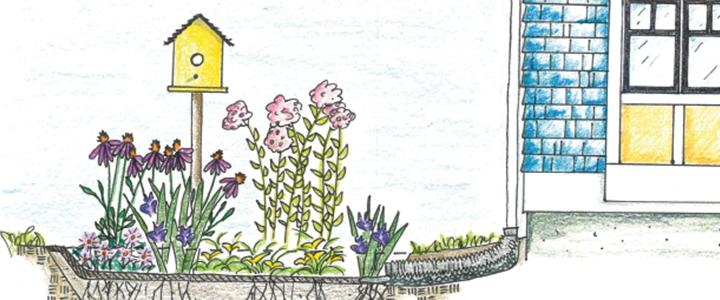
May 2020: Rain Gardens: A Beautiful Solution to Stormwater Runoff
Whether you are looking to enjoy more time in your yard or engage your child in a project, this may be a good time to enhance your yard with a special type of garden, called a rain garden, while helping protect the environment. What we do in our own backyards can affect the nearby lakes, rivers, streams and bays we love. By looking at our yards a little differently, we can do our part to help protect them.
A rain garden is a specialized type of garden that has a few unique features but otherwise is quite similar to a conventional perennial flower and shrub garden. Rain gardens are designed to capture rain and allow it to soak into the ground. By preventing stormwater runoff – water from rain and melting snow that does not soak into the ground – we can prevent water pollution, erosion, habitat degradation and more. Runoff is powerful. It can erode loose material like sand and soil, pick up toxins like pesticides, and liquefy substances like road salt. These harmful materials move with the runoff into our scenic brooks, flowing streams and rivers, and favorite ponds and lakes where they smother habitats, poison aquatic critters and cause water pollution.
Luckily, property owners can do their part to reduce runoff, and building a rain garden is a beautiful way to do so. Next time it rains, watch how the water falls on your roof, deck, driveway and yard. Look for areas that send water directly to a waterbody or to the road, where it enters a roadside ditch or catch basin. Strategically place your rain garden to capture this water to prevent it from running off your property. Direct your roof gutter downspout into your rain garden instead of down your driveway, for example. Or capture runoff from your compacted lawn by planting a rain garden along the runoff’s path.
The most unique rain garden feature is that it’s sunken down into the landscape to create a pooling area to capture the rain. As the captured water slowly filters down into the soil, plant roots and soils filter the water and groundwater supplies are replenished. A simple percolation test will tell you if your soil will allow this. (Find a link to instructions below.)
As for the size of the garden, all good rain garden guidance will provide you with instructions designed to capture a certain amount of rain. For example, the sizing instructions in the Soak Up the Rain New Hampshire (SOAKNH) Rain Garden Fact Sheet will guide you to build a rain garden to capture one inch of rain falling on the area you are capturing. However, your rain garden can be smaller or larger; just know that a smaller garden will overflow more often and a larger garden, less often.
Now comes the fun part! Create a beautiful, sustainable, backyard wildlife habitat by filling your rain garden with native grasses, ferns, flowering perennials and shrubs. Just be sure to use plants that can tolerate being inundated with water for up to a day or so. (A rain garden should drain out in about 24 hours to prevent creating a mosquito breeding area!) There are lots of plants to choose from. You can find lists online, including the SOAKNH Native Plants for New England Rain Gardens. Try to use at least 80% native plants in your rain garden (or any perennial garden) to provide local wildlife species with much-needed pollinating, feeding, nesting and other opportunities.
Find out how to do a simple percolation test, review the benefits of using native plants, see or print the SOAKNH Native Plant for New England Rain Gardens list and learn more about rain gardens, by visiting the SOAKNH Rain Garden Planning page.
If you’re not a gardener but would still like to do your part to prevent runoff and reduce water pollution, there are many other ways to help:
- Consider a rain barrel or two to capture your roof runoff.
- Build a dry well or an infiltration trench.
- Plant a vegetated buffer between your home and the water body you live by.
For more information on rain gardens and these other ideas, visit Soak Up the Rain New Hampshire and look for the Do-It-Yourself Fact Sheets under the Resources tab.
This GREENWorks article can be also be found in our document library.




